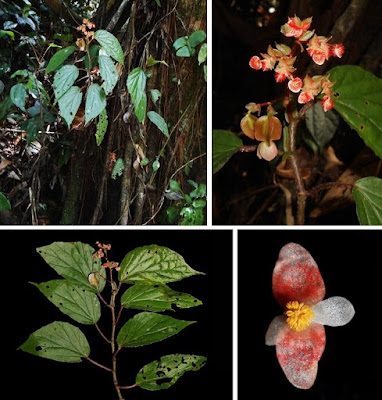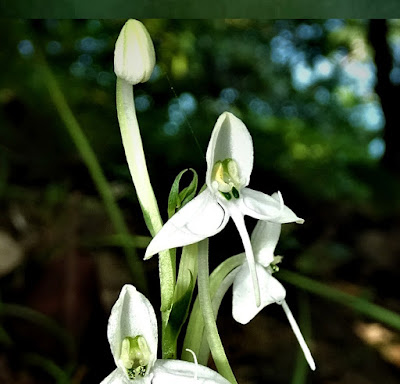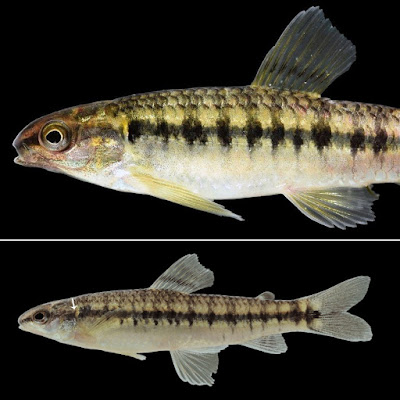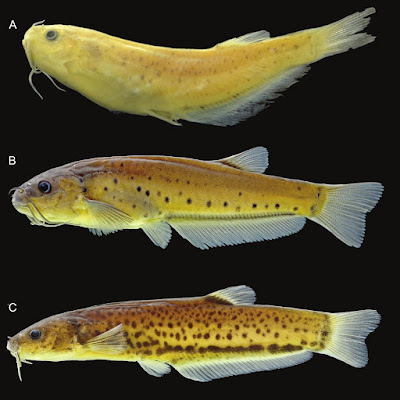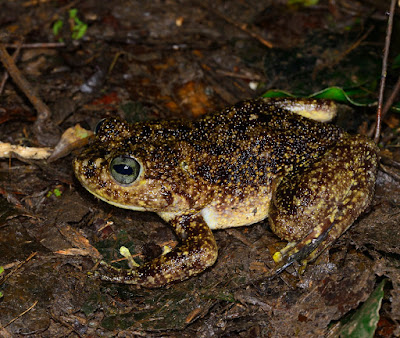[Most Recent Entries] [Calendar View]
Thursday, May 7th, 2020
| Time | Event | ||||||
| 6:02a | [Botany • 2019] Begonia bachmaensis & B. saolaensis (Begoniaceae) • Two New Cane-like Species of Begonia from central Vietnam
Abstract Two new cane-like species of Begonia from central Vietnam, Begonia bachmaensis and B. saolaensis, are described and illustrated. Begonia bachmaensis is similar to B. boisiana and does not fit within any of the current sections. Begonia saolaensis is similar to B. rubrosetosa and is assigned to Begonia sect. Petermannia. Begonia bachmaensis is classified as Data Deficient (DD) and B. saolaensis is assigned in the Endangered (EN) category according to IUCN criteria. Keywords: Begoniaceae, Begonia sect. Petermannia, central Vietnam, new species, Eudicots Begonia bachmaensis Y.M. Shui & T.T.D. Pham, sp. nov. Etymology:— The specific epithet is derived from its type locality, the Bach Ma National Park in Thua Thien Hue Province, Vietnam. Habitat:— The new species grows in moist soil along streams, on a shady slope in the subtropical evergreen forest. Distribution and ecology:— Begonia bachmaensisis is known only from Bach Ma National Park, Phu Loc district, Thua Thien Hue, central Vietnam (Fig. 1). Populations of this species were observed growing in moist shady areas in association with species of Ophiorrhiza Linnaeus (1753: 150), Mussaenda Linnaeus (1753: 177), Breynia Linnaeus (1753: 503), Distichochlamys citrea Newman (1995: 65), and other taxa. Begonia saolaensis Y.M. Shui, T.A. Le & C.T. Vu, sp. nov. Etymology:— The specific epithet is derived from its type locality, the Saola Nature Reserve in Thua Thien Hue province, Vietnam. Habitat:— It grows by the stream banks, in limestone forests. Distribution and ecology:— Begonia saolaensis is known only from Thuong Quang commune, Nam Dong district, Thua Thien Hue province, central Vietnam (Fig. 1). Populations were observed in the moist shady areas in association with Ophiorrhiza baviensis Drake (1895: 213), Paraphlomis membranacea Wu & Li (1965: 66), Schismatoglottis (1846: 83) sp., and other taxa. Yu-Min Shui, Chinh Tien Vu, Tuan Anh Le, Thi Thanh Dat Pham, Van Dat Nguyen, Thi Minh Hoang Duong and Li-Gong Lei. 2019. Two New Cane-like Species of Begonia L. (Begoniaceae) from central Vietnam. Phytotaxa. 411(1); 57–64. DOI: 10.11646/phytotaxa.411.1.5 | ||||||
| 7:12a | [Botany • 2020] Habenaria rangatensis (Orchidaceae) • A New Species from Andaman & Nicobar Islands, India
Abstract A new species of Habenaria (Orchidaceae), Habenaria rangatensis is described from stunted evergreen forest of Middle Andamans, Andaman & Nicobar Islands, India. This new species is morphologically similar to Habenaria acuifera but differ in certain characters, which are discussed below. A detailed description and photographs are provided for identification of the present novel species. Keywords: Middle Andamans, Orchideae, Orchidoideae, White flowers, Monocots Kothareddy Prasad and Mudavath Chennakesavulu Naik. 2020. Habenaria rangatensis (Orchidaceae), A New Species from Andaman & Nicobar Islands, India. Phytotaxa. 442(1); 27–32. DOI: 10.11646/phytotaxa.442.1.4 | ||||||
| 9:14a | [Ichthyology • 2020] Characidium chancoense • A New Species of South American Darter (Characiformes: Crenuchidae) from the Río Cauca Drainage, Colombia
Abstract Characidium chancoense new species, is described from the transandean upper Río Cauca drainage in Colombia. It can be distinguished from all congeners by its pigmentation pattern that consists of 7–12 vertical bars, most of which are cuneate-shaped with the vertex ending on or just below the lateral-line scale series, except for the last 1–4, which are dorsoventrally elongate rectangular bars that extend well below the lateral line. Characidium chancoense is sympatric with C. caucanum Eigenmann, C. phoxocephalum Eigenmann, C. cf. zebra Eigenmann and C. cf. boavistae Steindachner. Unlike C. caucanum and C. cf. boavistae, C. chancoense does not appear to be sexually dimorphic. Keywords: Pisces, Characidiinae, Swimbladder, Trans-Andean basins, Characidium caucanum, Characidium phoxocephalum
Henry D. Agudelo-Zamora, Armando Ortega-Lara and Donald C. B. Taphorn. 2020. Characidium chancoense, A New Species of South American Darter from the Río Cauca Drainage, Colombia (Characiformes: Crenuchidae). Zootaxa. 4768(2); 249–263 DOI: 10.11646/zootaxa.4768.2.6 | ||||||
| 9:51a | [Ichthyology • 2020] Trichogenes beagle • A New Species of Trichogenes (Siluriformes, Trichomycteridae), with A Discussion on the Homologies of the Anterior Orbital Bones in Trichomycterids and Other Loricarioids
Abstract A new species of the rare genus Trichogenes is reported on the basis of specimens without locality and other associated data. The obvious distinctiveness, taxonomic relevance, and phylogenetic importance of the new taxon justify its description with material at hand. Trichogenes beagle, new species, differs from all congeners by the presence of tricuspidate teeth on its jaws; by the distribution of opercular odontodes along a wide area of the margin of the opercle; by the pale integumentary pigmentation, composed of few scattered small spots on dorsum and flanks, but lacking large spots near the base of the anal fin; and by the absence of differential concentration of dark chromatophores along the base of the dorsal fin. The new species differs further from each of its two congeners, T. longipinnis and T. claviger, by various additional traits of internal and external morphology and pigmentation. Trichogenes beagle seems to be the closest relative of T. claviger, the two species sharing a number of putatively derived traits not present in T. longipinnis, such as the presence of a large anterodorsal clawlike process on the neural arches of the anterior four free vertebrae. The three species now included in Trichogenes share all synapomorphies previously proposed for the genus, thus strongly supporting generic monophyly. The enigmatic disc-shaped orbital bone in T. beagle and congeners is homologous to a topologically equivalent rodlike structure in other trichomycterids. New comparative information corroborates the hypothesis that the bone is a neomorphic structure, here called the barbular bone. Previous proposals of its homology with the antorbital or supraorbital are refuted. Ontogenetic data demonstrate that the anterior element of the infraorbital series in trichomycterids is a fusion between the lacrimal and antorbital, as postulated--but previously poorly demonstrated--for other catfishes. The structure of the opercle in the new species is intermediate between the highly derived morphology in most trichomycterids and the plesiomorphic condition in other loricarioids, helping to understand the evolution of the opercle of trichomycterids. New information on T. claviger is reported on the basis of additional material.
Trichogenes beagle, new species Etymology: The species epithet honors the Laboratory of Molecular Systematics – Beagle, Department of Animal Biology, Universidade Federal de Viçosa, the lab where the only specimens of the new species were found preserved. Mário de Pinna, Vinícius Reis and Heraldo Britski. 2020. A New Species of Trichogenes (Siluriformes, Trichomycteridae), with A Discussion on the Homologies of the Anterior Orbital Bones in Trichomycterids and Other Loricarioids. American Museum Novitates. 3951; 1-27. DOI: doi.org/10.1206/3951.1 | ||||||
| 10:46a | [Botany • 2020] Morphological and Anatomical Investigation of New Caledonian Graminoid Dendrobium (Orchidaceae) with the Description of Two New Species Abstract Morphological characters support the description of two new species of Orchidaceae from New Caledonia: Dendrobium butinii M.Pignal & Munzinger sp. nov. and Dendrobium letocartiorum Munzinger & M.Pignal sp. nov. The lectotypes of Dendrobium camaridiorum Rchb.f. and D. crassifolium Schltr. are designated here. A leaf anatomical study was conducted and provided useful characters to distinguish the five New Caledonian graminoid Dendrobiineae species. Two identification tools are provided: an anatomical key for sterile material of grass-like Dendrobiineae and a morphological key for the New Caledonian graminoid Dendrobium. We propose preliminary conservation assessments with IUCN criteria for the new taxa. Keywords. Orchidaceae, Grastidium, Dendrobium, Biloba, New Caledonia, taxonomy. 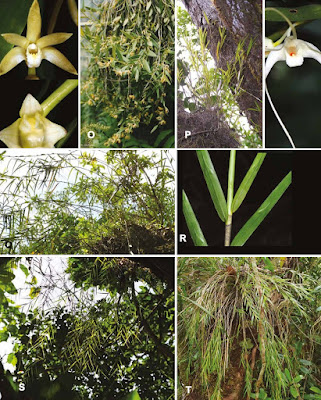   Marc Pigna and Jérôme Munzinger. 2020. Morphological and Anatomical Investigation of New Caledonian Graminoid Dendrobium (Orchidaceae) with the Description of Two New Species. European Journal of Taxonomy. 633: 1–26. DOI: 10.5852/ejt.2020.633 | ||||||
| 4:16p | [Herpetology • 2020] Mantidactylus radaka • Target-enriched DNA Sequencing from Historical Type Material enables A Partial Revision of the Madagascar Giant Stream Frogs (Genus Mantidactylus) ABSTRACT The subgenus Mantidactylus is a group of frogs endemic to Madagascar, including the largest anuran species on the island. Although these frogs are common and widely distributed, their taxonomy remains unclear. Two species are currently recognised, M. grandidieri and M. guttulatus, with another available name, Rana pigra, considered to be a synonym of M. grandidieri. However, molecular studies have suggested the presence of several cryptic species within the group. Additionally, due to the lack of prominent morphological features, allocating the available names to evolutionary lineages has proven challenging. In the present study, we take a first step towards solving these problems by using fragments of the 16S mitochondrial gene and RAG1 nuclear gene from all over the range of the subgenus to describe its genetic diversity. We also use a newly designed target enrichment laboratory protocol to sequence three mitochondrial fragments from five name-holding museum specimens (as old as 120 years) in order to determine to which lineages the existing names should be applied. The study of the 16S mitochondrial gene revealed 7 geographically separated lineages, distinct enough to be considered candidate species. Out of the five museum specimens analysed, four successfully yielded DNA sequences and could be attributed to one of the aforementioned lineages. Therefore, the name Mantidactylus grandidieri should be applied to the populations from North-Eastern Madagascar, while M. guttulatus refers to populations from inland localities along the Eastern coast of the island. On the other hand, the holotype of Rana pigra did not yield enough genetic material to allow definitive identification. While our data were not sufficient to assess the status of the four lineages distributed along the Eastern coast, the populations from North-Western Madagascar were highly distinct on both the mitochondrial and nuclear markers. We thus describe them as a new species, Mantidactylus radaka sp. nov. KEYWORDS: Anura, Mantidactylus guttulatus, Mantidactylus grandidieri, Mantidactylus radaka sp. nov, Madagascar, Target enrichment Systematics: Mantidactylus (Mantidactylus) guttulatus (Boulenger, 1881) Rana guttulata Boulenger, 1881 Rana pigra Mocquard, 1900. Holotype: MNHN 1899.410, from ‘forêt d’Ikongo’. Mantidactylus (Mantidactylus) grandidieri Mocquard, 1895
Mantidactylus (Mantidactylus) radaka new species Etymology. The species name is a noun in apposition to the genus name, and is the Malagasy word for large frogs in general (as opposed to ‘sahona’, which usually refers to small frogs), and those of the subgenus Mantidactylus in particular.
Loïs Rancilhac, Teddy Bruy, Mark D. Scherz, Elvis Almeida Pereira, Michaela Preick, Nicolas Straube, Mariana L. Lyra, Annemarie Ohler, Jeffrey W. Streicher, Franco Andreone, Angelica Crottini, Carl R. Hutter, J. Christian Randrianantoandro, Andolalao Rakotoarison, Frank Glaw, Michael Hofreiter and Miguel Vences. 2020. Target-enriched DNA Sequencing from Historical Type Material enables A Partial Revision of the Madagascar Giant Stream Frogs (Genus Mantidactylus). Journal of Natural History. DOI: 10.1080/00222933.2020.1748243 |
| << Previous Day |
2020/05/07 [Calendar] |
Next Day >> |
